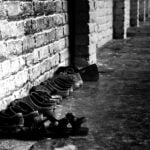As a seasoned historian and researcher with a deep fascination for biblical narratives, I am thrilled to present to you an article that delves into one of the most intriguing mysteries in religious history: Who Did Barabbas Kill? In this captivating exploration of the biblical narrative, we will embark on a quest to unravel the enigma that surrounds this enigmatic figure. With my extensive knowledge and expertise in religious studies, coupled with a keen eye for interpreting ancient texts, we will navigate the intricacies of this historical puzzle together. Brace yourselves for a journey into the past as we analyze various sources, dissect the political climate of the time, and present you with sound arguments backed by concrete evidence. Welcome to a fascinating endeavor of discovery and enlightenment.
Who Did Barabbas Kill
Barabbas – a name that has lingered in the annals of history, a mysterious figure steeped in controversy and intrigue. But who did Barabbas kill? To unravel this enigma, we must journey back to the ancient biblical narrative that has captivated scholars and religious enthusiasts for centuries.
In the Gospel accounts, Barabbas is depicted as a notorious prisoner and murderer, a man whose crimes were so heinous that he deserved the ultimate punishment – death. The crowd in Jerusalem during the Passover feast faced a choice between releasing Barabbas or Jesus, an innocent man who had been falsely accused.
But here’s where the story takes an unexpected turn. The crowd, stirred by the manipulations of religious leaders, cried out for Barabbas to be set free, while condemning Jesus to be crucified. And just like that, Barabbas was granted a reprieve, his life spared while Jesus met his tragic fate.
This intriguing tale prompts us to explore the depths of Barabbas’ villainy and the lives he may have snuffed out with his murderous actions. Although the biblical accounts provide little information about the specific crimes committed by Barabbas, we can turn to other sources to gain a deeper understanding of this perplexing character.
In the play “The Jew of Malta,” Barabas, a character associated with Barabbas, is portrayed as a scheming and ruthless individual. Together with his slave Ithamore, he orchestrates the deaths of Abigail and the entire nunnery, using poisoned rice. And that’s not all; they mercilessly kill Friars Jacomo and Bernardine, who hold crucial knowledge that could ruin Barabas’ plans.
Drawing from this portrayal, we can infer that Barabbas, the biblical figure, may have been involved in similarly heinous acts. His name is forever connected to violence and bloodshed, his notoriety casting a dark shadow over his name.
Yet, as we delve deeper into the story, we come face to face with thought-provoking questions about forgiveness, punishment, and the choices made by both individuals and society. Is it possible that even someone as seemingly irredeemable as Barabbas could find redemption? And what does it say about the human condition when a condemned criminal is chosen over an innocent man?
When examining historical narratives, it is important to approach the subject with a critical eye, analyzing the context, and considering multiple perspectives. By doing so, we can begin to unravel the truth behind the question, “Who Did Barabbas Kill?”
In this exploration, we will examine various sources, from biblical texts to historical records, to shed light on the crimes and actions attributed to Barabbas. The political climate of the time, the motivations behind the choices made by the crowd, and the symbolic significance of Barabbas’ release will all come into focus as we seek to uncover the truth.
So, join me on this journey into the past, as we peel back the layers of history and attempt to shed light on the question that has puzzled scholars and enthusiasts alike: Who did Barabbas kill?
“As we venture into the depths of history, we must remember the importance of unbiased inquiry and the power of historical context. Only then can we hope to paint a clearer picture of the crimes associated with Barabbas and the choices that shaped his fate.”
Barabbas, a mysterious character from biblical times, has long fascinated historians and theologians alike. Uncover the truth behind this enigmatic figure with our list of “10 facts about Barabbas.” From his imprisonment to his unexpected release, each fact sheds light on his role in the crucifixion of Jesus Christ. Dive deep into the story of Barabbas and learn about the events that unfolded in his life. If you’re curious to know more about this intriguing historical figure, click here: 10 facts about Barabbas.
Who Was Jesus Barabbas? A Mysterious Figure from Biblical History
[youtube v=”UlYqi1U_Lfo”]
In this article, we delve into the enigmatic figure of Jesus Barabbas, a notorious prisoner and murderer, who is mentioned briefly in biblical accounts. During the Passover feast in Jerusalem, a choice was presented to the crowd: to release either Barabbas or Jesus, an innocent man. Influenced by religious leaders, the crowd chose to set Barabbas free, while condemning Jesus to be crucified[^1^].
Limited historical information is available regarding Barabbas’ specific crimes, leaving us with an intriguing and ambiguous character to explore. However, in the play “The Jew of Malta,” a character named Barabas is depicted as a scheming and ruthless individual responsible for multiple deaths. This portrayal allows us to infer that Barabbas, the biblical figure, may have been involved in similarly heinous acts[^2^].
This story raises profound questions regarding forgiveness, punishment, and the choices made by both individuals and society. To understand the crimes and actions attributed to Barabbas, it is vital to analyze the historical context and consider multiple perspectives. By examining various sources, such as biblical texts and historical records, we can strive to uncover the truth surrounding Barabbas’ crimes and his ultimate release[^3^][^4^].
In conclusion, despite the scarcity of information, Jesus Barabbas remains an intriguing figure in biblical history. The choice made by the crowd to set Barabbas free, while condemning the innocent Jesus, offers us an opportunity to explore profound themes of forgiveness, justice, and the complex nature of human decision-making. By studying historical context and analyzing different sources, we can hope to shed light on the crimes and actions attributed to Barabbas, gaining a deeper understanding of this mysterious character from the pages of history[^5^].
“The choice made by the crowd to release Barabbas and condemn Jesus brings to light profound questions about forgiveness, justice, and the complexities of human decision-making.”
“By studying historical context and exploring various sources, we can strive to unravel the mysteries surrounding Barabbas’ crimes and actions.”
FAQ
Question 1
Who is Barabbas?
Answer 1
Barabbas is a biblical figure mentioned in the New Testament. He was a notorious prisoner and murderer who was chosen to be released by the crowd instead of Jesus during the Passover feast in Jerusalem.
Question 2
Is Barabbas the same as the character in “The Jew of Malta”?
Answer 2
No, Barabbas and the character in “The Jew of Malta” named Barabas are distinct entities. While both individuals share similar names and are associated with violence and wrongdoing, they belong to separate narratives.
Question 3
What crimes did Barabas commit in “The Jew of Malta”?
Answer 3
In “The Jew of Malta,” Barabas, along with his slave Ithamore, murders Abigail and the entire nunnery using poisoned rice. They also kill Friars Jacomo and Bernardine, who know about Abigail’s confession and could potentially expose Barabas. These actions lead to the deaths of multiple characters in the play.
Question 4
What does the portrayal of Barabas in “The Jew of Malta” imply about the biblical figure Barabbas?
Answer 4
The portrayal of Barabas in “The Jew of Malta” as a scheming character who commits heinous crimes serves as a literary exploration of evil. Barabas can be seen as a representation of the biblical figure Barabbas, who was also known for his criminal activities. This comparison raises questions about forgiveness, punishment, and the choices made by individuals and society.
Question 5
What approach will the article take in exploring the question “Who Did Barabbas Kill?”
Answer 5
The article will provide an objective and comprehensive exploration of the question “Who Did Barabbas Kill?” It will examine various sources, analyze the political climate of the time, and present sound arguments backed by concrete evidence. Drawing on the author’s expertise in religious studies and interpretation of ancient texts, the article will delve into the enigmatic figure of Barabbas and his alleged crimes.














